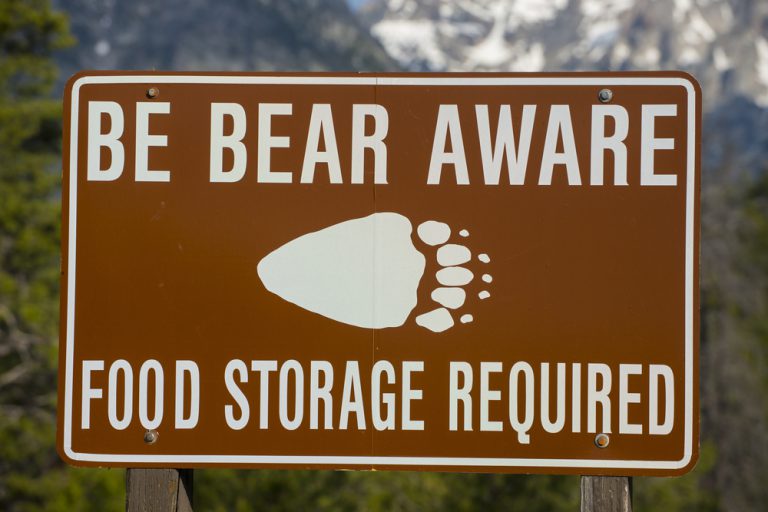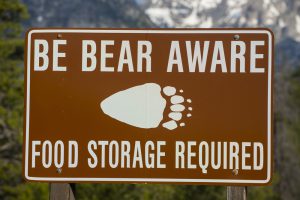
 We all have those two or three friends who’ve never gone on a camping trip before. Ever ask them why not?
We all have those two or three friends who’ve never gone on a camping trip before. Ever ask them why not?
One of the biggest reasons “city slickers” may turn a wary eye on wilderness adventure is the potential to encounter wild animals. After all, the whole point is to get away from civilization and out into nature… otherwise known as “home, sweet home” to bears, coyotes, and mountain lions.
Of course, in the vast majority of cases, these animals are just as afraid of you as you are of them — if not even more so. Think about it: If you’ve lived it the woods surrounded by trees and other four-legged critters like you your whole life, wouldn’t human beings be weird and kind of threatening? We’re all tall and two-legged, with a hunter’s forward-facing eyes and sharp incisors… not to mention those great big rumbling vehicles we ride around in!
The fact is, if you stay aware of your surroundings and take some fairly rudimentary precautions, you’re unlikely to have any trouble with the “locals” while you’re enjoying your time away from the hustle and bustle of town.
Here’s what you need to know about camping safety when it comes to wild animals.
Safety Measures for Camping
First of all, are you following standard camping safety procedures? Many camping rules are put into place to help make the experience as safe as possible — and not just in the case of encountering a bear or mountain lion.
For instance, if you’re wondering how safe it is to go camping alone, the answer is pretty clear: not as safe as it is in groups! Most parks and natural reserves post signage advising hikers and campers to always travel with at least one companion. And it’s not just for animal safety purposes: What if you stumble and break your leg? Out in the woods, you might not have cell phone signal, and if you’re alone, it may be impossible to hike your way out.
Of course, there’s a difference in the level of precaution you need to take if you’re going RV camping versus backcountry camping. When you’re traveling in an RV, you’re in a sturdy, metal or fiberglass vehicle with all the comforts of home. That’s not quite as dangerous as sleeping in a tent, where only a thin wall of canvas separates you from the force of nature!
But even in a motorhome, there are certain things you should know about wild animals before you set out on your trip.
Bear Safety While Camping
Wondering how to keep bears away from your campsite?
The answer is pretty simple: Don’t make them think it’s an all-you-can-eat buffet!
As mentioned above, bears generally aren’t aggressive toward humans without a reason — although if a mama bear thinks you’re threatening her cubs, you could be in for trouble. That won’t be a problem in any industrialized campsite, but if you’re boondocking, be on the lookout for signs that you’re in a bear’s area. That could include footprints and bear “scat,” or dung. You’d be cranky if someone dropped anchor in your backyard, too, right?
Obviously, RV camping in bear country always requires some extra attention when it comes to handling food. You can still grill and enjoy an outdoor meal, of course, but you need to ensure that all your leftovers, ingredients, food scraps, and garbage is securely put away before you leave your campsite unattended or go to bed. When a bear smells that delicious roasting meat — or even just your toothpaste, which smells like a delicious peppermint patty — she can’t help but want some for herself. Don’t tempt her in the first place, and she should give your noisy, fire-filled campsite a wide berth.
But even the most cautious campers will occasionally have a bear encounter, and it’s important to be prepared ahead of time. So: what’s the best thing to do if a bear enters your campsite?
The best safety tips when it comes to wild animals depend a lot on the specific animal you encounter. Black bears behave very differently than grizzlies, for instance, and there’s a different set of rules for how to repel and deal with each type.
There are so many amazing resources online that explain exactly what to do in a variety of camping scenarios should you cross paths with a bear. Here’s a comprehensive guide from the Grizzly and Wolf Discovery Center that covers the best courses of action whether you see a black or grizzly bear around camp.
There is one very important rule never to forget when it comes to bear safety: DON’T RUN. It might sound scary to stand your ground when facing such a large and powerful animal, but if you run, you’ll trigger the bear’s chase response… and trust me, even a world-class athlete can’t outrun a bear.
Mountain Lion Safety While Camping
Although they’re less commonly feared, there are a few other animals you might run into in the backcountry, like mountain lions, coyotes, wild dogs, wild boars, and snakes.
It’s important to educate yourself about all of the animals it’s possible to run into in your area. Different regions of the country are home to different kinds of critters, and they each have their own set of safety tips and rules. Here are a few great guides on some common ones:
- What to Do if You See a Coyote by CoyoteSmarts.org
- Safety in Encounters with Mountain Lions by Mountain Lion Foundation
- Wolf Safety by Western Wildlife Outreach
Always educate yourself on how to react to animal encounters before you head out into the wild!
Camping Food Safety
No matter where you’re camping or what type of animals live there, the most important camping safety rule when it comes to bears, wolves, and other wildlife is to secure your food. It’s the tempting smell of food that lures these wild animals towards scary humans int he first place!
Always practice camping cooking safety by purchasing and using heavy-duty food containers that thoroughly block any smell your food might create. You can also limit your foods to less pungent ones — for instance, rather than cooking juicy burgers, have some jerky or granola while you’re on your trip. (But don’t forget — even these need to be secured in sturdy containers! They don’t have no smell, just less.)
The same goes for garbage ingredients, leftovers, clothing — anything that could possibly have a food smell. In an RV, it’s pretty simple: Don’t leave that stuff outside, and don’t leave your windows open! But you can always purchase animal-safe food containers made specifically for camping.
We’re confident that if you follow these common sense guidelines, you’ll stay safe from any animals that might live where you’re vacationing. And if you do see a wild animal, enjoy it — from inside your rig, of course. Seeing new wildlife is one of the most exciting parts of camping trips!
